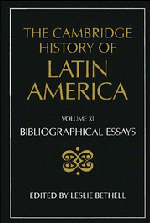Book contents
- Frontmatter
- I THE INDIGENOUS PEOPLES OF MIDDLE AND SOUTH AMERICA ON THE EVE OF THE CONQUEST
- II COLONIAL SPANISH AMERICA
- III COLONIAL BRAZIL
- IV THE INDEPENDENCE OF LATIN AMERICA
- V LATIN AMERICA: ECONOMY, SOCIETY, POLITICS, c. 1820 TO c. 1870
- VI LATIN AMERICA: ECONOMY, SOCIETY, POLITICS, c. 1870 to 1930
- VII LATIN AMERICA: ECONOMY, SOCIETY, POLITICS, 1930 to c. 1990
- 1 Population
- 2 The Latin American economies, 1929–1939
- 3 The Latin American economies, 1939–c. 1950
- 4 The Latin American economies, 1950–1990
- 5 Urban growth and urban social structure
- 6 Agrarian structures
- 7 State organization
- 8 Democracy
- 9 The Left
- 10 The military in politics
- 11 The urban working class and labour movements
- 12 Rural mobilizations
- 13 Women in twentieth-century Latin America
- 14 The Catholic church
- 15 The Protestant churches
- 16 Mexico, c. 1930–1946
- 17 Mexico since 1946
- 18 Central America
- 19 Guatemala
- 20 El Salvador
- 21 Honduras
- 22 Nicaragua
- 23 Costa Rica
- 24 Panama
- 25 The Panama Canal Zone, 1904–1979
- 26 Cuba, c. 1930–1959
- 27 Cuba since 1959
- 28 The Dominican Republic
- 29 Haiti
- 30 Puerto Rico
- 31 Argentina, 1930–1946
- 32 Argentina since 1946
- 33 Uruguay
- 34 Paraguay
- 35 Chile, c. 1930–c. 1960
- 36 Chile since c. 1960
- 37 Peru, 1930–c. 1960
- 38 Peru since c. 1960
- 39 Bolivia
- 40 Colombia
- 41 Ecuador
- 42 Venezuela
- 43 Brazil
- VIII IDEAS IN LATIN AMERICA SINCE INDEPENDENCE
- IX LATIN AMERICAN CULTURE SINCE INDEPENDENCE
- X THE INTERNATIONAL RELATIONS OF LATIN AMERICA SINCE INDEPENDENCE
- THE CAMBRIDGE HISTORY OF LATIN AMERICA
40 - Colombia
from VII - LATIN AMERICA: ECONOMY, SOCIETY, POLITICS, 1930 to c. 1990
Published online by Cambridge University Press: 28 March 2008
- Frontmatter
- I THE INDIGENOUS PEOPLES OF MIDDLE AND SOUTH AMERICA ON THE EVE OF THE CONQUEST
- II COLONIAL SPANISH AMERICA
- III COLONIAL BRAZIL
- IV THE INDEPENDENCE OF LATIN AMERICA
- V LATIN AMERICA: ECONOMY, SOCIETY, POLITICS, c. 1820 TO c. 1870
- VI LATIN AMERICA: ECONOMY, SOCIETY, POLITICS, c. 1870 to 1930
- VII LATIN AMERICA: ECONOMY, SOCIETY, POLITICS, 1930 to c. 1990
- 1 Population
- 2 The Latin American economies, 1929–1939
- 3 The Latin American economies, 1939–c. 1950
- 4 The Latin American economies, 1950–1990
- 5 Urban growth and urban social structure
- 6 Agrarian structures
- 7 State organization
- 8 Democracy
- 9 The Left
- 10 The military in politics
- 11 The urban working class and labour movements
- 12 Rural mobilizations
- 13 Women in twentieth-century Latin America
- 14 The Catholic church
- 15 The Protestant churches
- 16 Mexico, c. 1930–1946
- 17 Mexico since 1946
- 18 Central America
- 19 Guatemala
- 20 El Salvador
- 21 Honduras
- 22 Nicaragua
- 23 Costa Rica
- 24 Panama
- 25 The Panama Canal Zone, 1904–1979
- 26 Cuba, c. 1930–1959
- 27 Cuba since 1959
- 28 The Dominican Republic
- 29 Haiti
- 30 Puerto Rico
- 31 Argentina, 1930–1946
- 32 Argentina since 1946
- 33 Uruguay
- 34 Paraguay
- 35 Chile, c. 1930–c. 1960
- 36 Chile since c. 1960
- 37 Peru, 1930–c. 1960
- 38 Peru since c. 1960
- 39 Bolivia
- 40 Colombia
- 41 Ecuador
- 42 Venezuela
- 43 Brazil
- VIII IDEAS IN LATIN AMERICA SINCE INDEPENDENCE
- IX LATIN AMERICAN CULTURE SINCE INDEPENDENCE
- X THE INTERNATIONAL RELATIONS OF LATIN AMERICA SINCE INDEPENDENCE
- THE CAMBRIDGE HISTORY OF LATIN AMERICA
Summary
The only one-volume history of Colombia in English is David Bushnell, The Making of Modern Colombia: A Nation in Spite of Itself (Berkeley, 1993). One useful volume which embodies recent trends in the historiography is Darío Jaramillo Agudelo (comp.), La nueva historia de Colombia (Bogotá, 1976). This is complemented by Jaime Jaramillo Uribe et al., Manual de historia de Colombia, vol. 3 (Bogotá, 1982), and a contemporary reader, Mario Arrubla et al., Colombia: Hoy, 2nd ed. (Bogoté, 1978).
politics and society
On the politics of the 1930s and 1940s, see Daniel Pécaut, L’Ordre et la violence: Evolution socio-politique de la Colombie entre 1930 et 1953 (Paris, 1986); Christopher Abel, Política, iglesia y partidos en Colombia, 1886–1953 (Bogotá, 1987); and Terrence Burns Horgan, ‘The Liberals come to power, por debajo de la ruana: A study of the Enrique Olaya Herrera administration, 1930-1934’ (unpublished Ph.D. thesis, Vanderbilt University, 1983). Alvaro Tirado Mejía, Aspectos políticos del primer gobierno de Alfonso López Pumarejo, 1934–1938 (Bogotá, 1981), is a valuable introduction from a committed lopista perspective. On the economy, there are Rosemary Thorp and Carlos Londoño, ‘The effect of the Great Depression on the economies of Peru and Colombia’, and José Antonio Ocampo, ‘The Colombian economy in the 1930s’, in Rosemary Thorp (ed.), Latin America in the 1930s: The Role of the Periphery in World Crisis (London, 1984), which should be read with José Antonio Ocampo and Santiago Montenegro, Crisis mundial, protectión e industrializatión: Ensayos de historia economíca colombiana (Bogotá, 1984), Alvaro Tirado Mejía (ed.). Estado y economia (Bogotá, 1986) and Paul W. Drake, The Money Doctor in the Andes: The Kemmerer Missions, 1923–1933 (Durham, N.C., 1989).
- Type
- Chapter
- Information
- The Cambridge History of Latin America , pp. 810 - 826Publisher: Cambridge University PressPrint publication year: 1995

